Hospitality Consumer Behavior and Insight Report - Marketing Module
VerifiedAdded on 2023/01/19
|10
|2867
|95
Report
AI Summary
This report provides a comprehensive analysis of consumer behavior within the hospitality industry, using Travelodge UK as a case study. It explores the stages of consumer decision-making, from problem recognition to post-purchase evaluation, and emphasizes the importance of mapping the customer's path to purchase. The report contrasts B2B and B2C decision-making processes, highlighting the differences in buying behavior and marketing strategies. It also delves into various market research approaches and methods used to understand consumer preferences and behaviors. Furthermore, the report examines how marketers can influence each stage of the decision-making process, including consumer learning, the impact of cultural and economic factors, and the use of digital audience research. The analysis covers aspects such as heuristics, marketing mix elements, personality traits, and the evaluation of digital media for audience research. Overall, the report offers valuable insights into the complexities of consumer behavior in the hospitality sector and effective marketing strategies for influencing consumer choices.
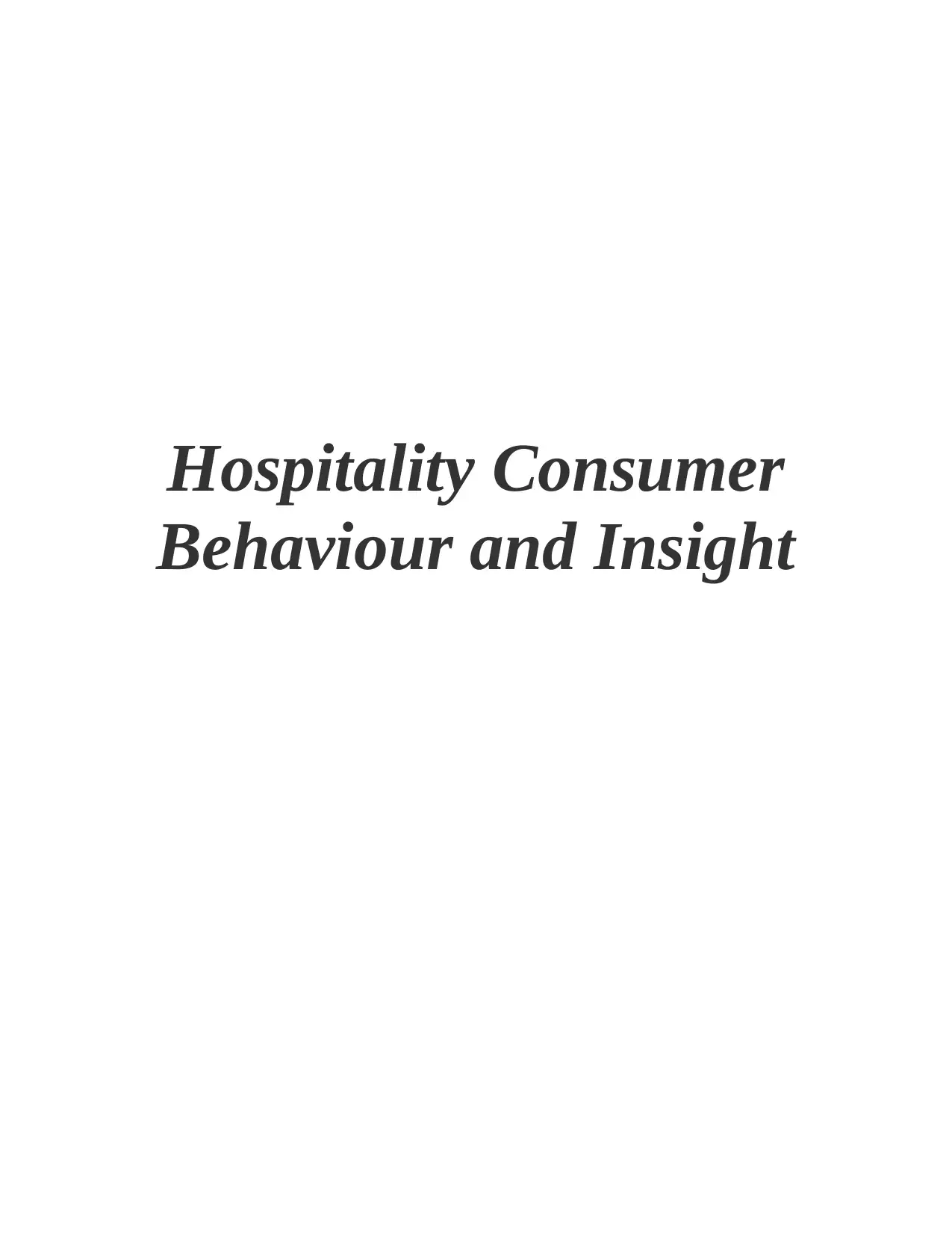
Hospitality Consumer
Behaviour and Insight
Behaviour and Insight
Paraphrase This Document
Need a fresh take? Get an instant paraphrase of this document with our AI Paraphraser
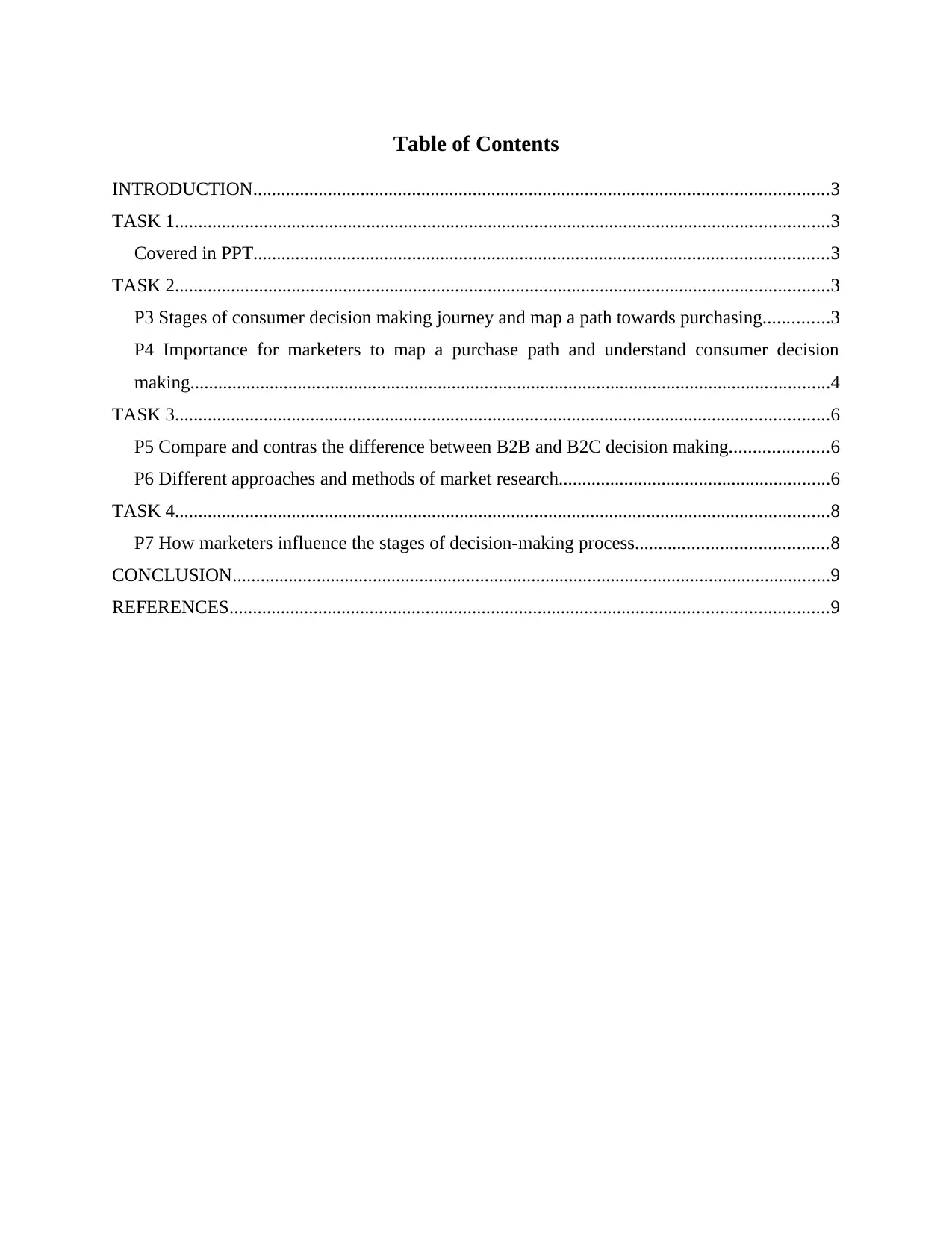
Table of Contents
INTRODUCTION...........................................................................................................................3
TASK 1............................................................................................................................................3
Covered in PPT...........................................................................................................................3
TASK 2............................................................................................................................................3
P3 Stages of consumer decision making journey and map a path towards purchasing..............3
P4 Importance for marketers to map a purchase path and understand consumer decision
making.........................................................................................................................................4
TASK 3............................................................................................................................................6
P5 Compare and contras the difference between B2B and B2C decision making.....................6
P6 Different approaches and methods of market research..........................................................6
TASK 4............................................................................................................................................8
P7 How marketers influence the stages of decision-making process.........................................8
CONCLUSION................................................................................................................................9
REFERENCES................................................................................................................................9
INTRODUCTION...........................................................................................................................3
TASK 1............................................................................................................................................3
Covered in PPT...........................................................................................................................3
TASK 2............................................................................................................................................3
P3 Stages of consumer decision making journey and map a path towards purchasing..............3
P4 Importance for marketers to map a purchase path and understand consumer decision
making.........................................................................................................................................4
TASK 3............................................................................................................................................6
P5 Compare and contras the difference between B2B and B2C decision making.....................6
P6 Different approaches and methods of market research..........................................................6
TASK 4............................................................................................................................................8
P7 How marketers influence the stages of decision-making process.........................................8
CONCLUSION................................................................................................................................9
REFERENCES................................................................................................................................9
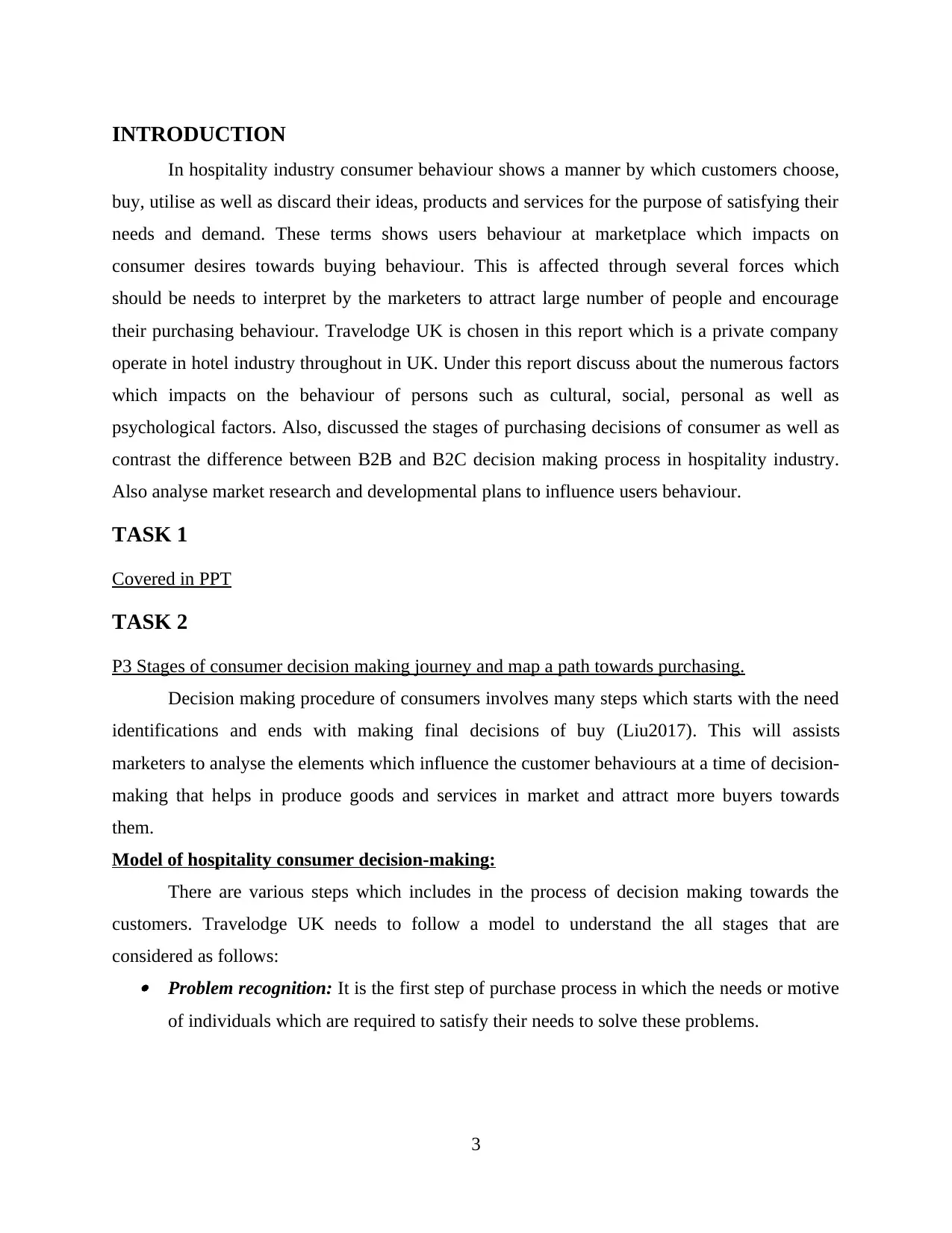
INTRODUCTION
In hospitality industry consumer behaviour shows a manner by which customers choose,
buy, utilise as well as discard their ideas, products and services for the purpose of satisfying their
needs and demand. These terms shows users behaviour at marketplace which impacts on
consumer desires towards buying behaviour. This is affected through several forces which
should be needs to interpret by the marketers to attract large number of people and encourage
their purchasing behaviour. Travelodge UK is chosen in this report which is a private company
operate in hotel industry throughout in UK. Under this report discuss about the numerous factors
which impacts on the behaviour of persons such as cultural, social, personal as well as
psychological factors. Also, discussed the stages of purchasing decisions of consumer as well as
contrast the difference between B2B and B2C decision making process in hospitality industry.
Also analyse market research and developmental plans to influence users behaviour.
TASK 1
Covered in PPT
TASK 2
P3 Stages of consumer decision making journey and map a path towards purchasing.
Decision making procedure of consumers involves many steps which starts with the need
identifications and ends with making final decisions of buy (Liu2017). This will assists
marketers to analyse the elements which influence the customer behaviours at a time of decision-
making that helps in produce goods and services in market and attract more buyers towards
them.
Model of hospitality consumer decision-making:
There are various steps which includes in the process of decision making towards the
customers. Travelodge UK needs to follow a model to understand the all stages that are
considered as follows: Problem recognition: It is the first step of purchase process in which the needs or motive
of individuals which are required to satisfy their needs to solve these problems.
3
In hospitality industry consumer behaviour shows a manner by which customers choose,
buy, utilise as well as discard their ideas, products and services for the purpose of satisfying their
needs and demand. These terms shows users behaviour at marketplace which impacts on
consumer desires towards buying behaviour. This is affected through several forces which
should be needs to interpret by the marketers to attract large number of people and encourage
their purchasing behaviour. Travelodge UK is chosen in this report which is a private company
operate in hotel industry throughout in UK. Under this report discuss about the numerous factors
which impacts on the behaviour of persons such as cultural, social, personal as well as
psychological factors. Also, discussed the stages of purchasing decisions of consumer as well as
contrast the difference between B2B and B2C decision making process in hospitality industry.
Also analyse market research and developmental plans to influence users behaviour.
TASK 1
Covered in PPT
TASK 2
P3 Stages of consumer decision making journey and map a path towards purchasing.
Decision making procedure of consumers involves many steps which starts with the need
identifications and ends with making final decisions of buy (Liu2017). This will assists
marketers to analyse the elements which influence the customer behaviours at a time of decision-
making that helps in produce goods and services in market and attract more buyers towards
them.
Model of hospitality consumer decision-making:
There are various steps which includes in the process of decision making towards the
customers. Travelodge UK needs to follow a model to understand the all stages that are
considered as follows: Problem recognition: It is the first step of purchase process in which the needs or motive
of individuals which are required to satisfy their needs to solve these problems.
3
⊘ This is a preview!⊘
Do you want full access?
Subscribe today to unlock all pages.

Trusted by 1+ million students worldwide
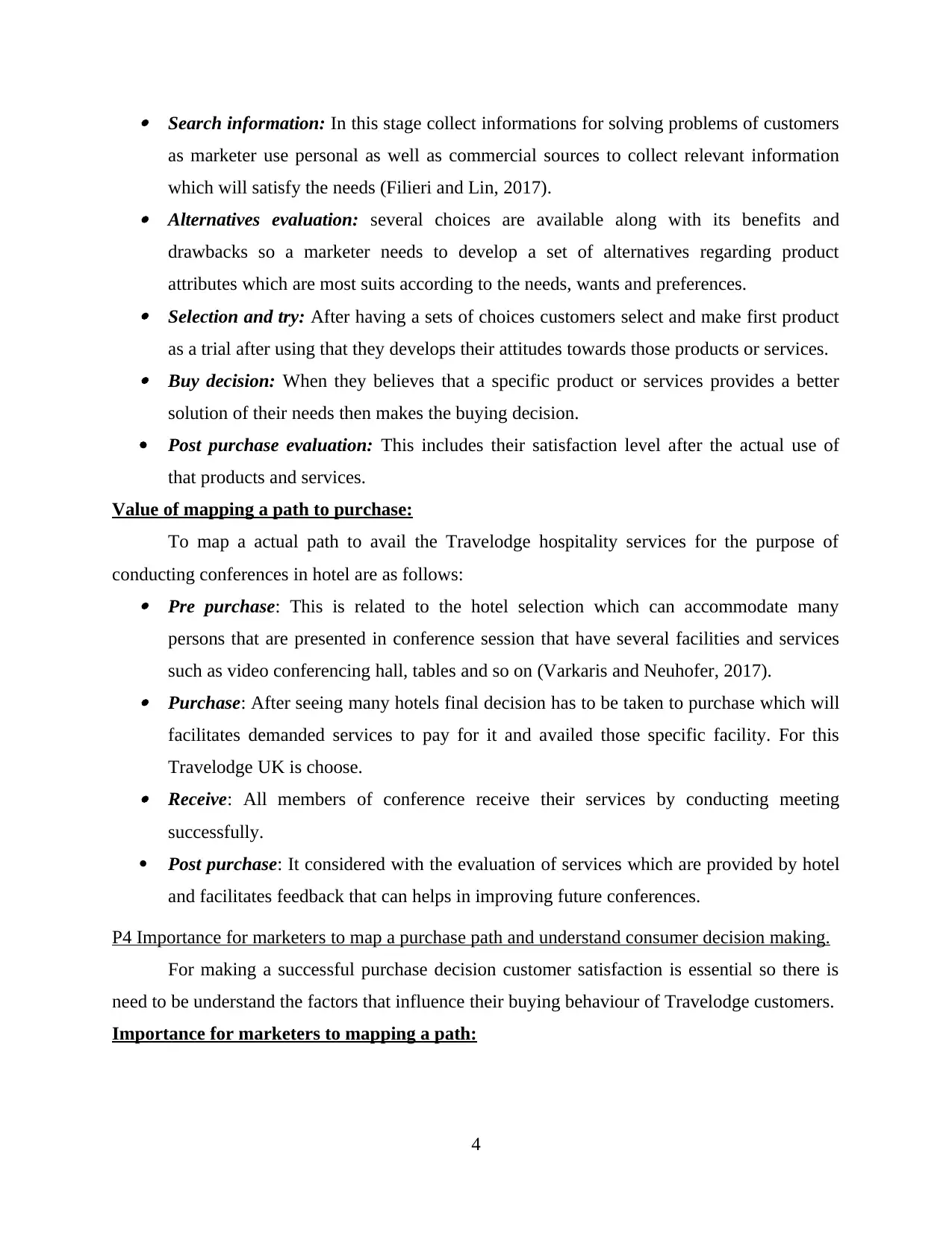
Search information: In this stage collect informations for solving problems of customers
as marketer use personal as well as commercial sources to collect relevant information
which will satisfy the needs (Filieri and Lin, 2017). Alternatives evaluation: several choices are available along with its benefits and
drawbacks so a marketer needs to develop a set of alternatives regarding product
attributes which are most suits according to the needs, wants and preferences. Selection and try: After having a sets of choices customers select and make first product
as a trial after using that they develops their attitudes towards those products or services. Buy decision: When they believes that a specific product or services provides a better
solution of their needs then makes the buying decision.
Post purchase evaluation: This includes their satisfaction level after the actual use of
that products and services.
Value of mapping a path to purchase:
To map a actual path to avail the Travelodge hospitality services for the purpose of
conducting conferences in hotel are as follows: Pre purchase: This is related to the hotel selection which can accommodate many
persons that are presented in conference session that have several facilities and services
such as video conferencing hall, tables and so on (Varkaris and Neuhofer, 2017). Purchase: After seeing many hotels final decision has to be taken to purchase which will
facilitates demanded services to pay for it and availed those specific facility. For this
Travelodge UK is choose. Receive: All members of conference receive their services by conducting meeting
successfully.
Post purchase: It considered with the evaluation of services which are provided by hotel
and facilitates feedback that can helps in improving future conferences.
P4 Importance for marketers to map a purchase path and understand consumer decision making.
For making a successful purchase decision customer satisfaction is essential so there is
need to be understand the factors that influence their buying behaviour of Travelodge customers.
Importance for marketers to mapping a path:
4
as marketer use personal as well as commercial sources to collect relevant information
which will satisfy the needs (Filieri and Lin, 2017). Alternatives evaluation: several choices are available along with its benefits and
drawbacks so a marketer needs to develop a set of alternatives regarding product
attributes which are most suits according to the needs, wants and preferences. Selection and try: After having a sets of choices customers select and make first product
as a trial after using that they develops their attitudes towards those products or services. Buy decision: When they believes that a specific product or services provides a better
solution of their needs then makes the buying decision.
Post purchase evaluation: This includes their satisfaction level after the actual use of
that products and services.
Value of mapping a path to purchase:
To map a actual path to avail the Travelodge hospitality services for the purpose of
conducting conferences in hotel are as follows: Pre purchase: This is related to the hotel selection which can accommodate many
persons that are presented in conference session that have several facilities and services
such as video conferencing hall, tables and so on (Varkaris and Neuhofer, 2017). Purchase: After seeing many hotels final decision has to be taken to purchase which will
facilitates demanded services to pay for it and availed those specific facility. For this
Travelodge UK is choose. Receive: All members of conference receive their services by conducting meeting
successfully.
Post purchase: It considered with the evaluation of services which are provided by hotel
and facilitates feedback that can helps in improving future conferences.
P4 Importance for marketers to map a purchase path and understand consumer decision making.
For making a successful purchase decision customer satisfaction is essential so there is
need to be understand the factors that influence their buying behaviour of Travelodge customers.
Importance for marketers to mapping a path:
4
Paraphrase This Document
Need a fresh take? Get an instant paraphrase of this document with our AI Paraphraser
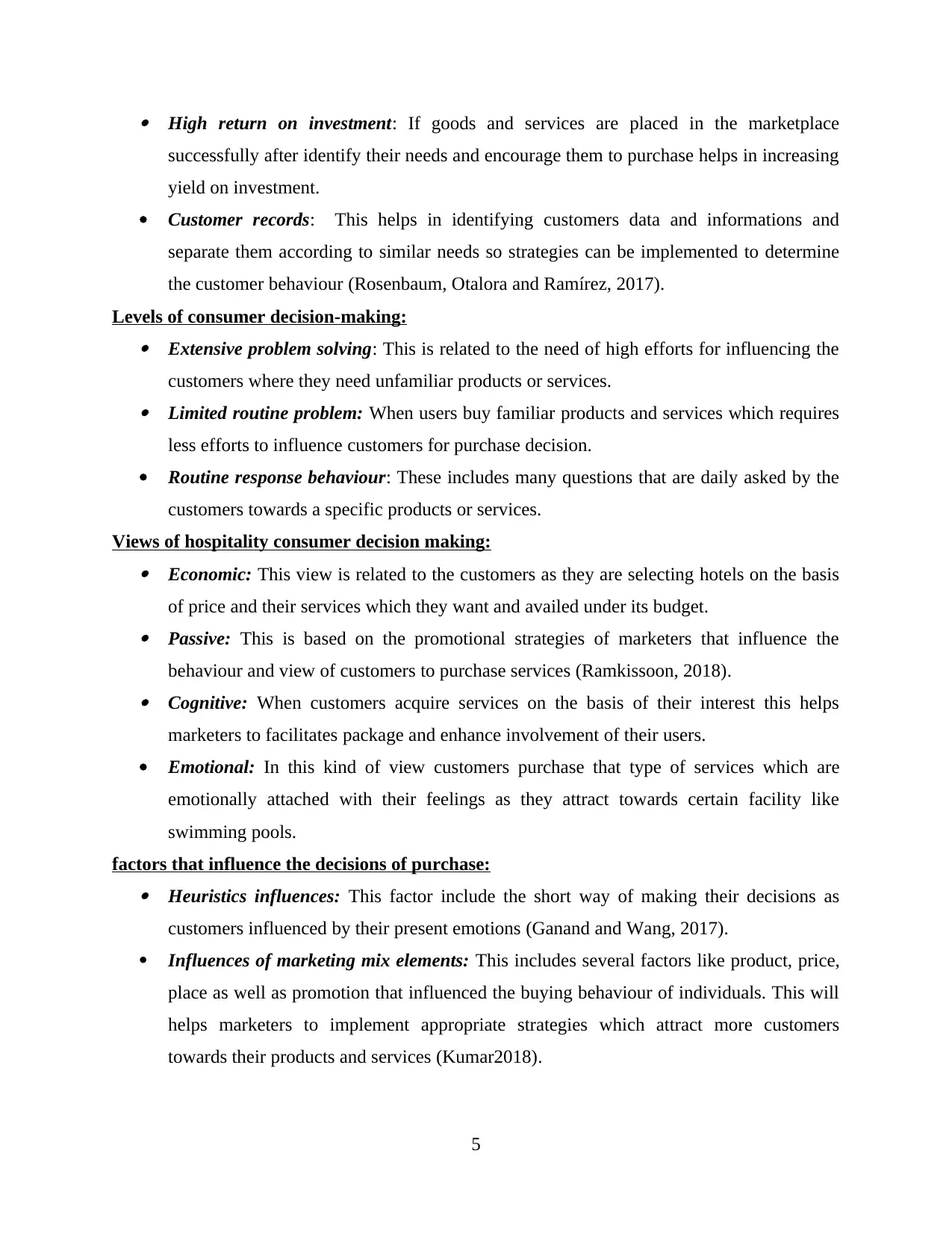
High return on investment: If goods and services are placed in the marketplace
successfully after identify their needs and encourage them to purchase helps in increasing
yield on investment.
Customer records: This helps in identifying customers data and informations and
separate them according to similar needs so strategies can be implemented to determine
the customer behaviour (Rosenbaum, Otalora and Ramírez, 2017).
Levels of consumer decision-making: Extensive problem solving: This is related to the need of high efforts for influencing the
customers where they need unfamiliar products or services. Limited routine problem: When users buy familiar products and services which requires
less efforts to influence customers for purchase decision.
Routine response behaviour: These includes many questions that are daily asked by the
customers towards a specific products or services.
Views of hospitality consumer decision making: Economic: This view is related to the customers as they are selecting hotels on the basis
of price and their services which they want and availed under its budget. Passive: This is based on the promotional strategies of marketers that influence the
behaviour and view of customers to purchase services (Ramkissoon, 2018). Cognitive: When customers acquire services on the basis of their interest this helps
marketers to facilitates package and enhance involvement of their users.
Emotional: In this kind of view customers purchase that type of services which are
emotionally attached with their feelings as they attract towards certain facility like
swimming pools.
factors that influence the decisions of purchase: Heuristics influences: This factor include the short way of making their decisions as
customers influenced by their present emotions (Ganand and Wang, 2017).
Influences of marketing mix elements: This includes several factors like product, price,
place as well as promotion that influenced the buying behaviour of individuals. This will
helps marketers to implement appropriate strategies which attract more customers
towards their products and services (Kumar2018).
5
successfully after identify their needs and encourage them to purchase helps in increasing
yield on investment.
Customer records: This helps in identifying customers data and informations and
separate them according to similar needs so strategies can be implemented to determine
the customer behaviour (Rosenbaum, Otalora and Ramírez, 2017).
Levels of consumer decision-making: Extensive problem solving: This is related to the need of high efforts for influencing the
customers where they need unfamiliar products or services. Limited routine problem: When users buy familiar products and services which requires
less efforts to influence customers for purchase decision.
Routine response behaviour: These includes many questions that are daily asked by the
customers towards a specific products or services.
Views of hospitality consumer decision making: Economic: This view is related to the customers as they are selecting hotels on the basis
of price and their services which they want and availed under its budget. Passive: This is based on the promotional strategies of marketers that influence the
behaviour and view of customers to purchase services (Ramkissoon, 2018). Cognitive: When customers acquire services on the basis of their interest this helps
marketers to facilitates package and enhance involvement of their users.
Emotional: In this kind of view customers purchase that type of services which are
emotionally attached with their feelings as they attract towards certain facility like
swimming pools.
factors that influence the decisions of purchase: Heuristics influences: This factor include the short way of making their decisions as
customers influenced by their present emotions (Ganand and Wang, 2017).
Influences of marketing mix elements: This includes several factors like product, price,
place as well as promotion that influenced the buying behaviour of individuals. This will
helps marketers to implement appropriate strategies which attract more customers
towards their products and services (Kumar2018).
5
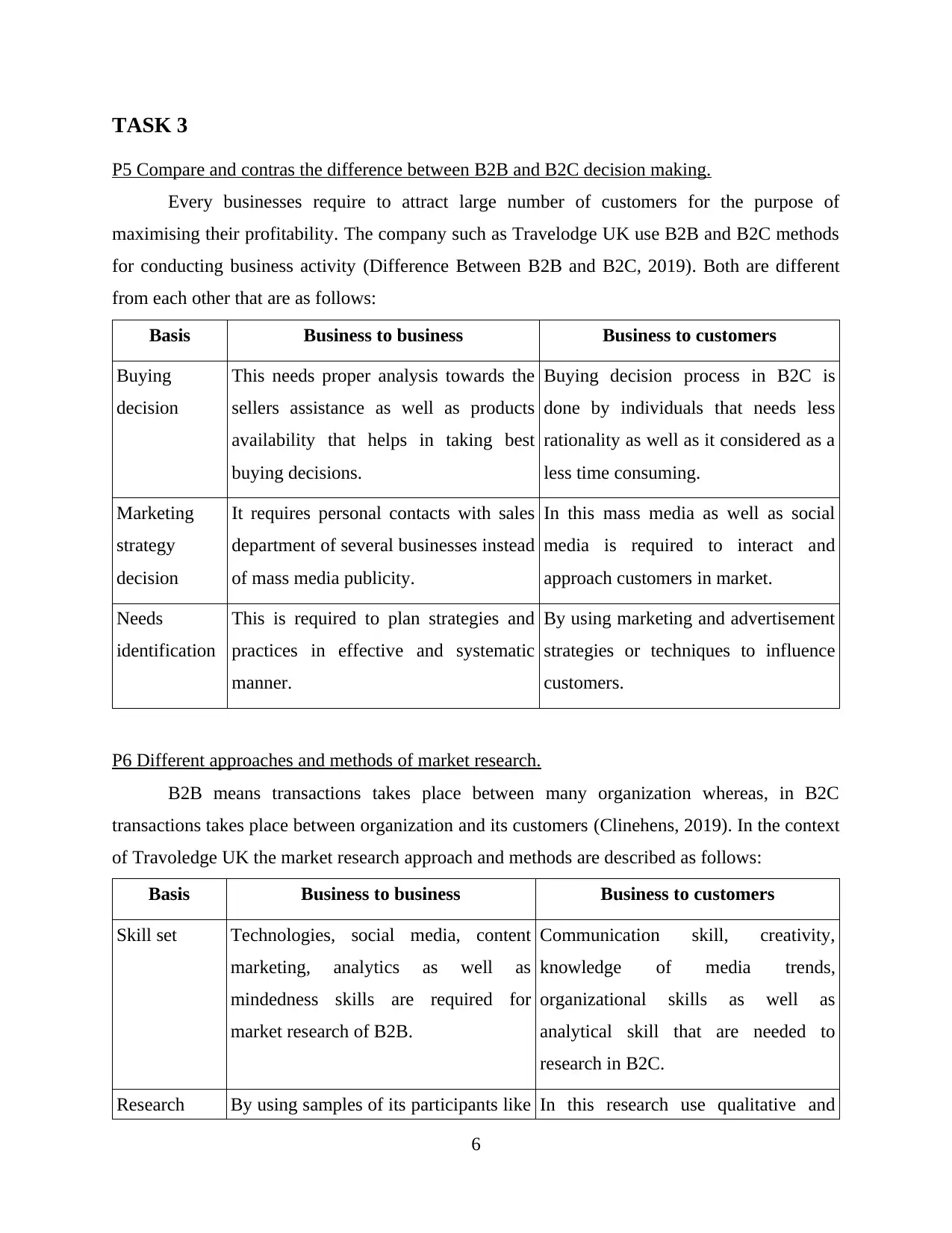
TASK 3
P5 Compare and contras the difference between B2B and B2C decision making.
Every businesses require to attract large number of customers for the purpose of
maximising their profitability. The company such as Travelodge UK use B2B and B2C methods
for conducting business activity (Difference Between B2B and B2C, 2019). Both are different
from each other that are as follows:
Basis Business to business Business to customers
Buying
decision
This needs proper analysis towards the
sellers assistance as well as products
availability that helps in taking best
buying decisions.
Buying decision process in B2C is
done by individuals that needs less
rationality as well as it considered as a
less time consuming.
Marketing
strategy
decision
It requires personal contacts with sales
department of several businesses instead
of mass media publicity.
In this mass media as well as social
media is required to interact and
approach customers in market.
Needs
identification
This is required to plan strategies and
practices in effective and systematic
manner.
By using marketing and advertisement
strategies or techniques to influence
customers.
P6 Different approaches and methods of market research.
B2B means transactions takes place between many organization whereas, in B2C
transactions takes place between organization and its customers (Clinehens, 2019). In the context
of Travoledge UK the market research approach and methods are described as follows:
Basis Business to business Business to customers
Skill set Technologies, social media, content
marketing, analytics as well as
mindedness skills are required for
market research of B2B.
Communication skill, creativity,
knowledge of media trends,
organizational skills as well as
analytical skill that are needed to
research in B2C.
Research By using samples of its participants like In this research use qualitative and
6
P5 Compare and contras the difference between B2B and B2C decision making.
Every businesses require to attract large number of customers for the purpose of
maximising their profitability. The company such as Travelodge UK use B2B and B2C methods
for conducting business activity (Difference Between B2B and B2C, 2019). Both are different
from each other that are as follows:
Basis Business to business Business to customers
Buying
decision
This needs proper analysis towards the
sellers assistance as well as products
availability that helps in taking best
buying decisions.
Buying decision process in B2C is
done by individuals that needs less
rationality as well as it considered as a
less time consuming.
Marketing
strategy
decision
It requires personal contacts with sales
department of several businesses instead
of mass media publicity.
In this mass media as well as social
media is required to interact and
approach customers in market.
Needs
identification
This is required to plan strategies and
practices in effective and systematic
manner.
By using marketing and advertisement
strategies or techniques to influence
customers.
P6 Different approaches and methods of market research.
B2B means transactions takes place between many organization whereas, in B2C
transactions takes place between organization and its customers (Clinehens, 2019). In the context
of Travoledge UK the market research approach and methods are described as follows:
Basis Business to business Business to customers
Skill set Technologies, social media, content
marketing, analytics as well as
mindedness skills are required for
market research of B2B.
Communication skill, creativity,
knowledge of media trends,
organizational skills as well as
analytical skill that are needed to
research in B2C.
Research By using samples of its participants like In this research use qualitative and
6
⊘ This is a preview!⊘
Do you want full access?
Subscribe today to unlock all pages.

Trusted by 1+ million students worldwide
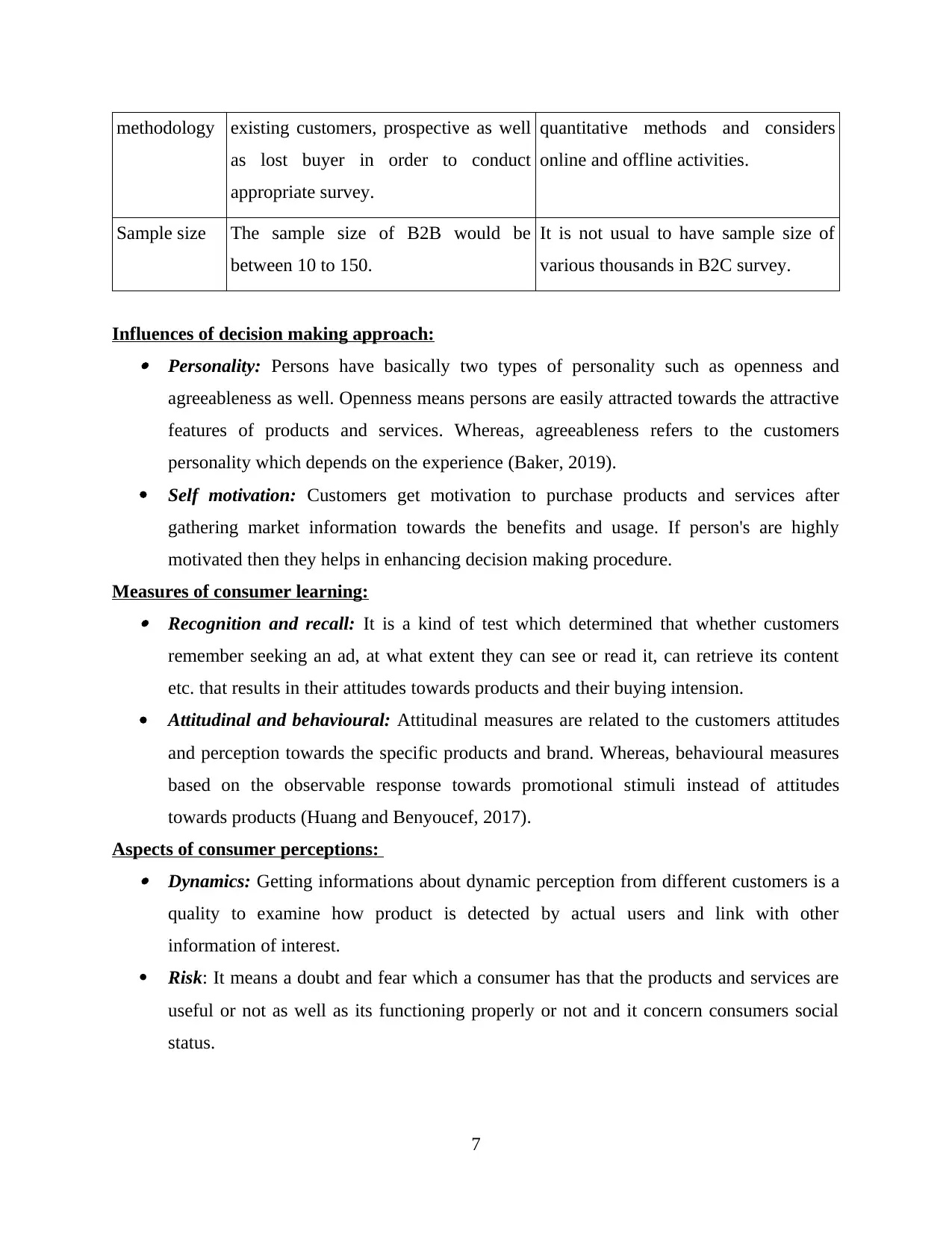
methodology existing customers, prospective as well
as lost buyer in order to conduct
appropriate survey.
quantitative methods and considers
online and offline activities.
Sample size The sample size of B2B would be
between 10 to 150.
It is not usual to have sample size of
various thousands in B2C survey.
Influences of decision making approach: Personality: Persons have basically two types of personality such as openness and
agreeableness as well. Openness means persons are easily attracted towards the attractive
features of products and services. Whereas, agreeableness refers to the customers
personality which depends on the experience (Baker, 2019).
Self motivation: Customers get motivation to purchase products and services after
gathering market information towards the benefits and usage. If person's are highly
motivated then they helps in enhancing decision making procedure.
Measures of consumer learning: Recognition and recall: It is a kind of test which determined that whether customers
remember seeking an ad, at what extent they can see or read it, can retrieve its content
etc. that results in their attitudes towards products and their buying intension.
Attitudinal and behavioural: Attitudinal measures are related to the customers attitudes
and perception towards the specific products and brand. Whereas, behavioural measures
based on the observable response towards promotional stimuli instead of attitudes
towards products (Huang and Benyoucef, 2017).
Aspects of consumer perceptions: Dynamics: Getting informations about dynamic perception from different customers is a
quality to examine how product is detected by actual users and link with other
information of interest.
Risk: It means a doubt and fear which a consumer has that the products and services are
useful or not as well as its functioning properly or not and it concern consumers social
status.
7
as lost buyer in order to conduct
appropriate survey.
quantitative methods and considers
online and offline activities.
Sample size The sample size of B2B would be
between 10 to 150.
It is not usual to have sample size of
various thousands in B2C survey.
Influences of decision making approach: Personality: Persons have basically two types of personality such as openness and
agreeableness as well. Openness means persons are easily attracted towards the attractive
features of products and services. Whereas, agreeableness refers to the customers
personality which depends on the experience (Baker, 2019).
Self motivation: Customers get motivation to purchase products and services after
gathering market information towards the benefits and usage. If person's are highly
motivated then they helps in enhancing decision making procedure.
Measures of consumer learning: Recognition and recall: It is a kind of test which determined that whether customers
remember seeking an ad, at what extent they can see or read it, can retrieve its content
etc. that results in their attitudes towards products and their buying intension.
Attitudinal and behavioural: Attitudinal measures are related to the customers attitudes
and perception towards the specific products and brand. Whereas, behavioural measures
based on the observable response towards promotional stimuli instead of attitudes
towards products (Huang and Benyoucef, 2017).
Aspects of consumer perceptions: Dynamics: Getting informations about dynamic perception from different customers is a
quality to examine how product is detected by actual users and link with other
information of interest.
Risk: It means a doubt and fear which a consumer has that the products and services are
useful or not as well as its functioning properly or not and it concern consumers social
status.
7
Paraphrase This Document
Need a fresh take? Get an instant paraphrase of this document with our AI Paraphraser
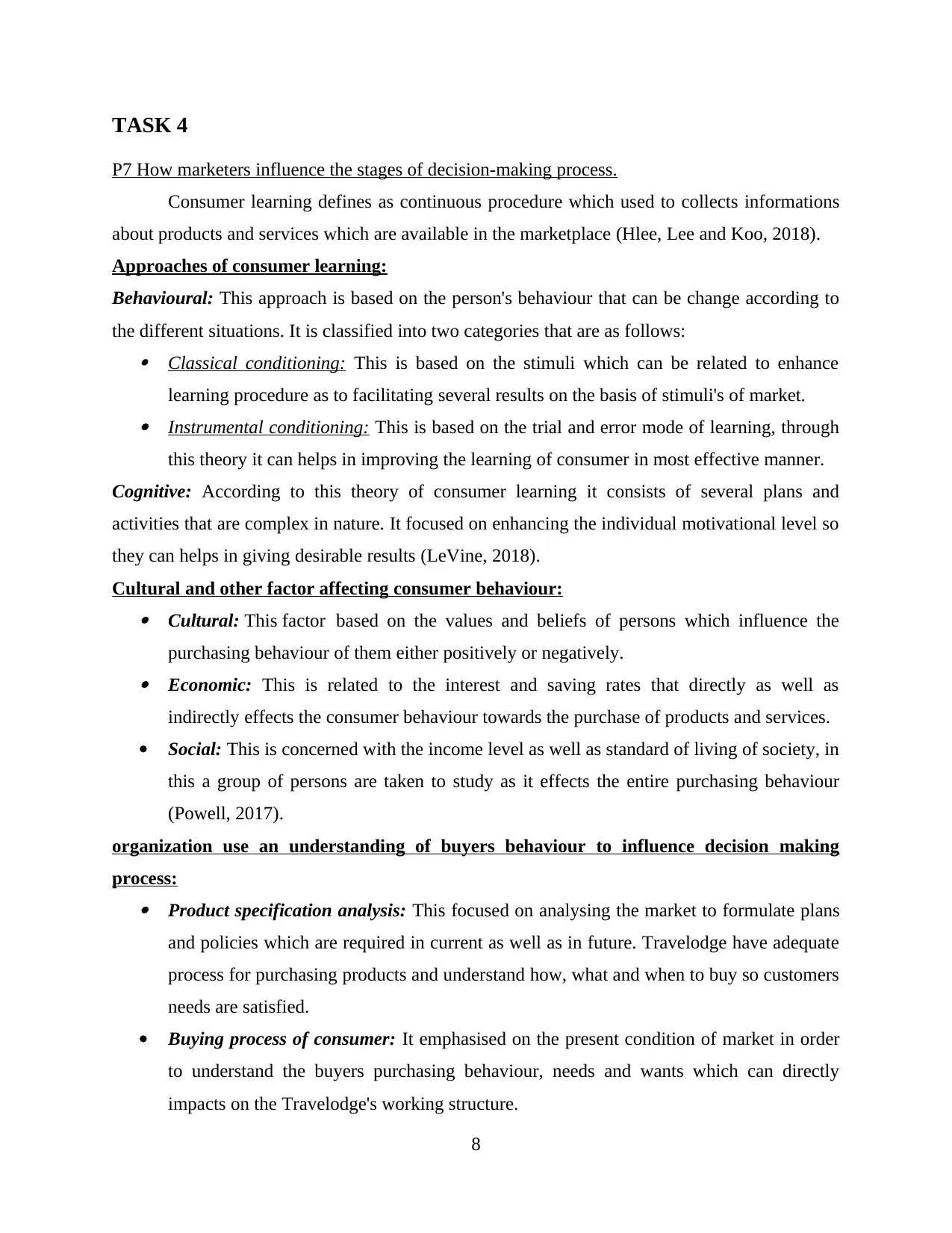
TASK 4
P7 How marketers influence the stages of decision-making process.
Consumer learning defines as continuous procedure which used to collects informations
about products and services which are available in the marketplace (Hlee, Lee and Koo, 2018).
Approaches of consumer learning:
Behavioural: This approach is based on the person's behaviour that can be change according to
the different situations. It is classified into two categories that are as follows: Classical conditioning: This is based on the stimuli which can be related to enhance
learning procedure as to facilitating several results on the basis of stimuli's of market. Instrumental conditioning: This is based on the trial and error mode of learning, through
this theory it can helps in improving the learning of consumer in most effective manner.
Cognitive: According to this theory of consumer learning it consists of several plans and
activities that are complex in nature. It focused on enhancing the individual motivational level so
they can helps in giving desirable results (LeVine, 2018).
Cultural and other factor affecting consumer behaviour: Cultural: This factor based on the values and beliefs of persons which influence the
purchasing behaviour of them either positively or negatively. Economic: This is related to the interest and saving rates that directly as well as
indirectly effects the consumer behaviour towards the purchase of products and services.
Social: This is concerned with the income level as well as standard of living of society, in
this a group of persons are taken to study as it effects the entire purchasing behaviour
(Powell, 2017).
organization use an understanding of buyers behaviour to influence decision making
process: Product specification analysis: This focused on analysing the market to formulate plans
and policies which are required in current as well as in future. Travelodge have adequate
process for purchasing products and understand how, what and when to buy so customers
needs are satisfied.
Buying process of consumer: It emphasised on the present condition of market in order
to understand the buyers purchasing behaviour, needs and wants which can directly
impacts on the Travelodge's working structure.
8
P7 How marketers influence the stages of decision-making process.
Consumer learning defines as continuous procedure which used to collects informations
about products and services which are available in the marketplace (Hlee, Lee and Koo, 2018).
Approaches of consumer learning:
Behavioural: This approach is based on the person's behaviour that can be change according to
the different situations. It is classified into two categories that are as follows: Classical conditioning: This is based on the stimuli which can be related to enhance
learning procedure as to facilitating several results on the basis of stimuli's of market. Instrumental conditioning: This is based on the trial and error mode of learning, through
this theory it can helps in improving the learning of consumer in most effective manner.
Cognitive: According to this theory of consumer learning it consists of several plans and
activities that are complex in nature. It focused on enhancing the individual motivational level so
they can helps in giving desirable results (LeVine, 2018).
Cultural and other factor affecting consumer behaviour: Cultural: This factor based on the values and beliefs of persons which influence the
purchasing behaviour of them either positively or negatively. Economic: This is related to the interest and saving rates that directly as well as
indirectly effects the consumer behaviour towards the purchase of products and services.
Social: This is concerned with the income level as well as standard of living of society, in
this a group of persons are taken to study as it effects the entire purchasing behaviour
(Powell, 2017).
organization use an understanding of buyers behaviour to influence decision making
process: Product specification analysis: This focused on analysing the market to formulate plans
and policies which are required in current as well as in future. Travelodge have adequate
process for purchasing products and understand how, what and when to buy so customers
needs are satisfied.
Buying process of consumer: It emphasised on the present condition of market in order
to understand the buyers purchasing behaviour, needs and wants which can directly
impacts on the Travelodge's working structure.
8
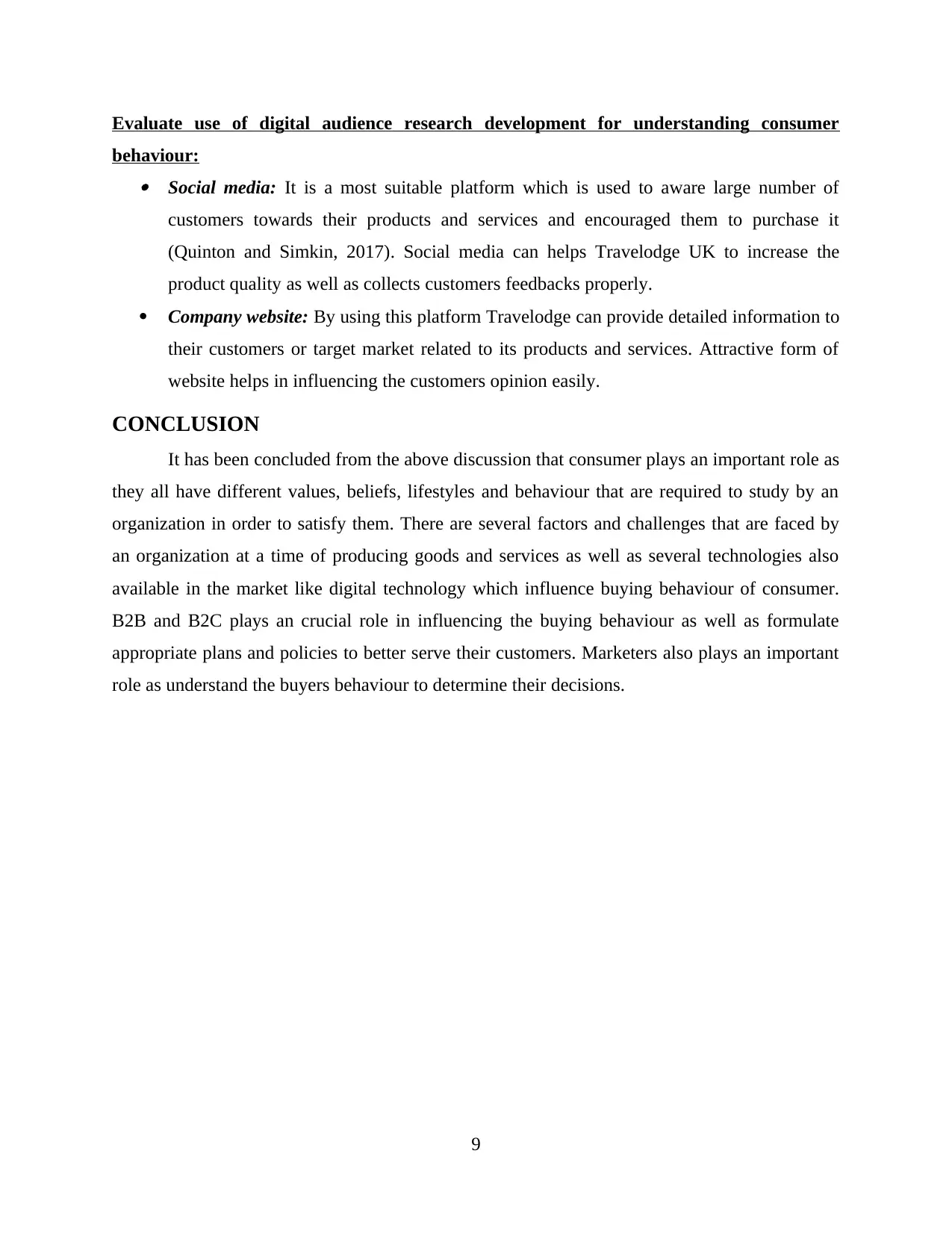
Evaluate use of digital audience research development for understanding consumer
behaviour: Social media: It is a most suitable platform which is used to aware large number of
customers towards their products and services and encouraged them to purchase it
(Quinton and Simkin, 2017). Social media can helps Travelodge UK to increase the
product quality as well as collects customers feedbacks properly.
Company website: By using this platform Travelodge can provide detailed information to
their customers or target market related to its products and services. Attractive form of
website helps in influencing the customers opinion easily.
CONCLUSION
It has been concluded from the above discussion that consumer plays an important role as
they all have different values, beliefs, lifestyles and behaviour that are required to study by an
organization in order to satisfy them. There are several factors and challenges that are faced by
an organization at a time of producing goods and services as well as several technologies also
available in the market like digital technology which influence buying behaviour of consumer.
B2B and B2C plays an crucial role in influencing the buying behaviour as well as formulate
appropriate plans and policies to better serve their customers. Marketers also plays an important
role as understand the buyers behaviour to determine their decisions.
9
behaviour: Social media: It is a most suitable platform which is used to aware large number of
customers towards their products and services and encouraged them to purchase it
(Quinton and Simkin, 2017). Social media can helps Travelodge UK to increase the
product quality as well as collects customers feedbacks properly.
Company website: By using this platform Travelodge can provide detailed information to
their customers or target market related to its products and services. Attractive form of
website helps in influencing the customers opinion easily.
CONCLUSION
It has been concluded from the above discussion that consumer plays an important role as
they all have different values, beliefs, lifestyles and behaviour that are required to study by an
organization in order to satisfy them. There are several factors and challenges that are faced by
an organization at a time of producing goods and services as well as several technologies also
available in the market like digital technology which influence buying behaviour of consumer.
B2B and B2C plays an crucial role in influencing the buying behaviour as well as formulate
appropriate plans and policies to better serve their customers. Marketers also plays an important
role as understand the buyers behaviour to determine their decisions.
9
⊘ This is a preview!⊘
Do you want full access?
Subscribe today to unlock all pages.

Trusted by 1+ million students worldwide
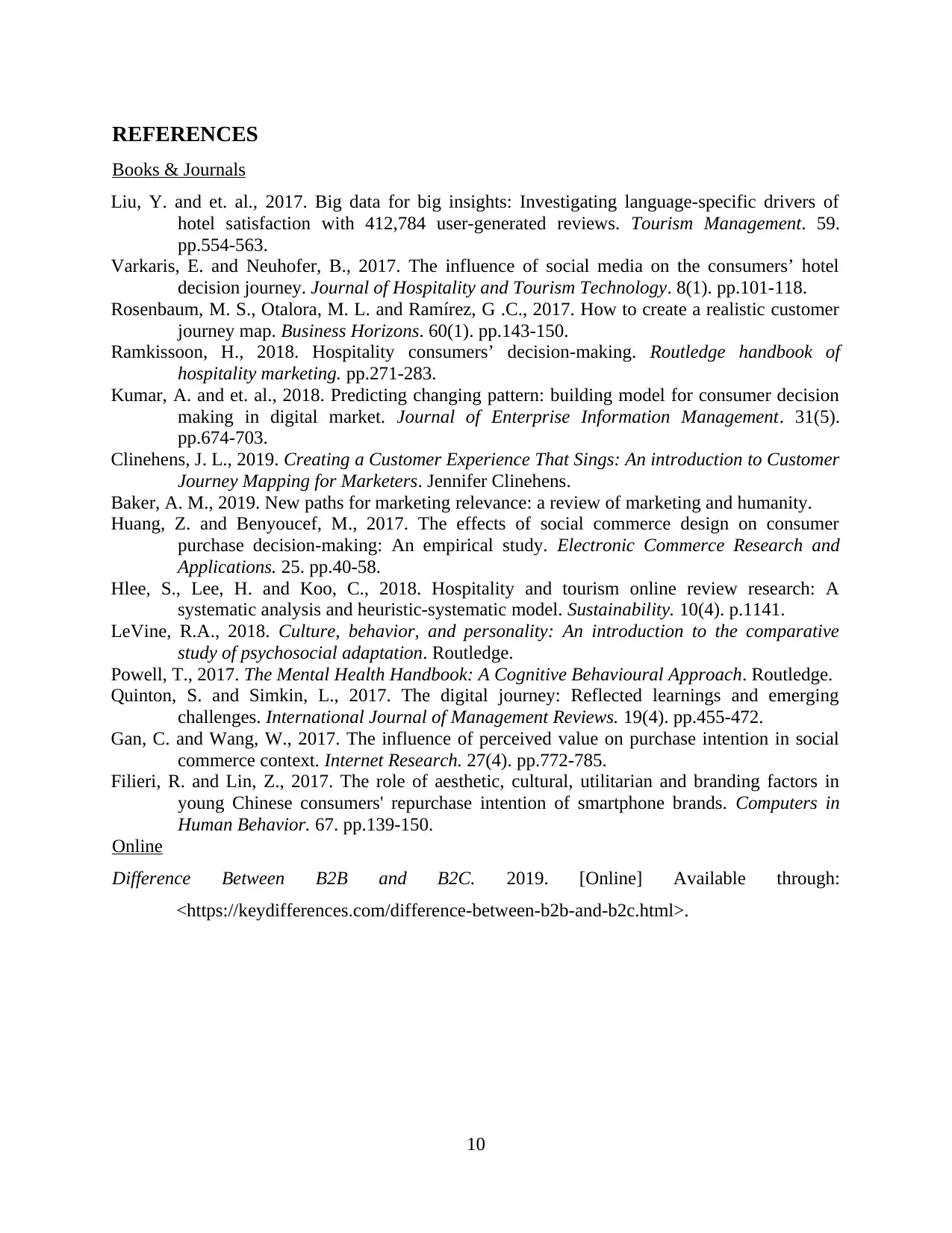
REFERENCES
Books & Journals
Liu, Y. and et. al., 2017. Big data for big insights: Investigating language-specific drivers of
hotel satisfaction with 412,784 user-generated reviews. Tourism Management. 59.
pp.554-563.
Varkaris, E. and Neuhofer, B., 2017. The influence of social media on the consumers’ hotel
decision journey. Journal of Hospitality and Tourism Technology. 8(1). pp.101-118.
Rosenbaum, M. S., Otalora, M. L. and Ramírez, G .C., 2017. How to create a realistic customer
journey map. Business Horizons. 60(1). pp.143-150.
Ramkissoon, H., 2018. Hospitality consumers’ decision-making. Routledge handbook of
hospitality marketing. pp.271-283.
Kumar, A. and et. al., 2018. Predicting changing pattern: building model for consumer decision
making in digital market. Journal of Enterprise Information Management. 31(5).
pp.674-703.
Clinehens, J. L., 2019. Creating a Customer Experience That Sings: An introduction to Customer
Journey Mapping for Marketers. Jennifer Clinehens.
Baker, A. M., 2019. New paths for marketing relevance: a review of marketing and humanity.
Huang, Z. and Benyoucef, M., 2017. The effects of social commerce design on consumer
purchase decision-making: An empirical study. Electronic Commerce Research and
Applications. 25. pp.40-58.
Hlee, S., Lee, H. and Koo, C., 2018. Hospitality and tourism online review research: A
systematic analysis and heuristic-systematic model. Sustainability. 10(4). p.1141.
LeVine, R.A., 2018. Culture, behavior, and personality: An introduction to the comparative
study of psychosocial adaptation. Routledge.
Powell, T., 2017. The Mental Health Handbook: A Cognitive Behavioural Approach. Routledge.
Quinton, S. and Simkin, L., 2017. The digital journey: Reflected learnings and emerging
challenges. International Journal of Management Reviews. 19(4). pp.455-472.
Gan, C. and Wang, W., 2017. The influence of perceived value on purchase intention in social
commerce context. Internet Research. 27(4). pp.772-785.
Filieri, R. and Lin, Z., 2017. The role of aesthetic, cultural, utilitarian and branding factors in
young Chinese consumers' repurchase intention of smartphone brands. Computers in
Human Behavior. 67. pp.139-150.
Online
Difference Between B2B and B2C. 2019. [Online] Available through:
<https://keydifferences.com/difference-between-b2b-and-b2c.html>.
10
Books & Journals
Liu, Y. and et. al., 2017. Big data for big insights: Investigating language-specific drivers of
hotel satisfaction with 412,784 user-generated reviews. Tourism Management. 59.
pp.554-563.
Varkaris, E. and Neuhofer, B., 2017. The influence of social media on the consumers’ hotel
decision journey. Journal of Hospitality and Tourism Technology. 8(1). pp.101-118.
Rosenbaum, M. S., Otalora, M. L. and Ramírez, G .C., 2017. How to create a realistic customer
journey map. Business Horizons. 60(1). pp.143-150.
Ramkissoon, H., 2018. Hospitality consumers’ decision-making. Routledge handbook of
hospitality marketing. pp.271-283.
Kumar, A. and et. al., 2018. Predicting changing pattern: building model for consumer decision
making in digital market. Journal of Enterprise Information Management. 31(5).
pp.674-703.
Clinehens, J. L., 2019. Creating a Customer Experience That Sings: An introduction to Customer
Journey Mapping for Marketers. Jennifer Clinehens.
Baker, A. M., 2019. New paths for marketing relevance: a review of marketing and humanity.
Huang, Z. and Benyoucef, M., 2017. The effects of social commerce design on consumer
purchase decision-making: An empirical study. Electronic Commerce Research and
Applications. 25. pp.40-58.
Hlee, S., Lee, H. and Koo, C., 2018. Hospitality and tourism online review research: A
systematic analysis and heuristic-systematic model. Sustainability. 10(4). p.1141.
LeVine, R.A., 2018. Culture, behavior, and personality: An introduction to the comparative
study of psychosocial adaptation. Routledge.
Powell, T., 2017. The Mental Health Handbook: A Cognitive Behavioural Approach. Routledge.
Quinton, S. and Simkin, L., 2017. The digital journey: Reflected learnings and emerging
challenges. International Journal of Management Reviews. 19(4). pp.455-472.
Gan, C. and Wang, W., 2017. The influence of perceived value on purchase intention in social
commerce context. Internet Research. 27(4). pp.772-785.
Filieri, R. and Lin, Z., 2017. The role of aesthetic, cultural, utilitarian and branding factors in
young Chinese consumers' repurchase intention of smartphone brands. Computers in
Human Behavior. 67. pp.139-150.
Online
Difference Between B2B and B2C. 2019. [Online] Available through:
<https://keydifferences.com/difference-between-b2b-and-b2c.html>.
10
1 out of 10
Related Documents
Your All-in-One AI-Powered Toolkit for Academic Success.
+13062052269
info@desklib.com
Available 24*7 on WhatsApp / Email
![[object Object]](/_next/static/media/star-bottom.7253800d.svg)
Unlock your academic potential
Copyright © 2020–2025 A2Z Services. All Rights Reserved. Developed and managed by ZUCOL.




